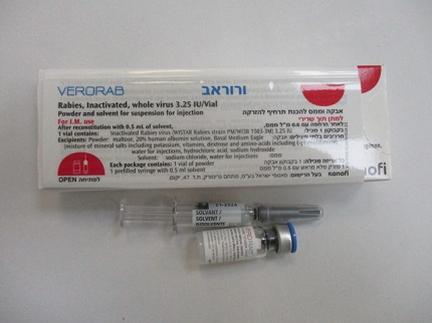Quest for the right Drug

ורוראב VERORAB (RABIES, INACTIVATED, WHOLE VIRUS)
תרופה במרשם
תרופה בסל
נרקוטיקה
ציטוטוקסיקה
צורת מתן:
תוך-שרירי : I.M
צורת מינון:
אבקה וממס להכנת תרחיף להזרקה : POWDER AND SOLVENT FOR SUSPENSION FOR INJECTION
עלון לרופא
מינוניםPosology התוויות
Indications תופעות לוואי
Adverse reactions התוויות נגד
Contraindications אינטראקציות
Interactions מינון יתר
Overdose הריון/הנקה
Pregnancy & Lactation אוכלוסיות מיוחדות
Special populations תכונות פרמקולוגיות
Pharmacological properties מידע רוקחי
Pharmaceutical particulars אזהרת שימוש
Special Warning עלון לרופא
Physicians Leaflet
Indications : התוויות
4.1. Therapeutic indications Verorab is indicated for the prevention of rabies in children and adults. It can be used before and after exposure to the rabies virus, as a primary vaccination or as a booster dose. Pre-Exposure Prevention of Rabies (Pre-Exposure Vaccination) Pre-exposure vaccination should be offered to subjects at high risk of contamination by the rabies virus. All those at permanent risk, such as the personnel of a diagnostic, research or production laboratory working with the rabies virus, should be vaccinated. A serological test is recommended every 6 months (see section 4.4) . Pre-exposure vaccination should also be considered for subjects at frequent risk of exposure to the rabies virus, such as: - veterinarians, veterinarians’ assistants, and animal handlers - those who, either by profession or leisure activity, are in contact with species such as dogs, cats, skunks, raccoons, bats or other species likely to have rabies. Examples of such people are gamekeepers, hunters, forestry workers, speleologists and taxidermists . - adults and children living or travelling in enzootic areas. A serological test can be performed every 2 to 3 years for those subject to discontinuous exposure . In areas where the enzootic level of rabies is low, veterinarians and their assistants (including students), animal handlers and wildlife officers (gamekeepers) are considered to be at occasional risk of exposure and should receive a primary vaccination against rabies. Serological tests for rabies antibodies should be performed at regular intervals in accordance with the subject’s risk of exposure. Systematic booster injections should be administered in accordance with the subject’s risk of exposure. The frequency of booster injections is described in section 4.2. Post-Exposure Prevention of Rabies (Post-Exposure Vaccination) Upon the slightest risk of rabies contamination, post-exposure vaccination should be performed as soon as possible . In some countries, vaccination must be performed in a specialized rabies treatment centre. Post-exposure treatment includes local, non-specific treatment of the injury, passive immunisation with rabies immunoglobulins (RIGs) and vaccination, depending on the type of injury and the status of the animal (see Tables 1 and 2). Table 1: Course of Action Depending on the Status of the Animal Circumstances Course of Action Comments Regarding The animal The patient Animal unavailable To be taken to a Treatment(b) is always completed Suspect or non- rabies treatment suspect centre for treatment circumstances Dead animal Suspect or Send the brain to an To be taken to a Treatment(b) is discontinued if the non- suspect approved laboratory for rabies treatment analyses are negative or, circumstances analysis centre for treatment. otherwise, continued Live animal Non-suspect Place under veterinary Decision to delay Treatment(b) is adapted circumstances supervision(a) rabies treatment according to the results of veterinary supervision of the animal Suspect Place under To be taken to a Treatment(b) is circumstances veterinary supervision(a) rabies treatment discontinued if veterinary centre for treatment. supervision invalidates the initial doubts, or, otherwise, continued (a) Veterinary supervision includes 3 certificates, drawn up on D0, D7, and D14, declaring the absence of signs of rabies. According to WHO recommendations, the minimum observation period under veterinary supervision for dogs and cats is 10 days. (b) Treatment is recommended depending on the severity of the wound: see Table below. Table 2: WHO Guidelines on Post-Exposure Treatment Depending on Wound Severity Category Type of contact with a wild(a) or domestic Recommended treatment of animal presumed or confirmed rabid or an severity animal that cannot be placed under supervision I Touching or feeding of animals None, if a reliable case history can Licks on intact skin be obtained II Nibbling of uncovered skin Administer vaccine immediately(b) Minor scratches or abrasions without bleeding Licks on broken skin III Single or multiple transdermal bites or Administer rabies immunoglobulins scratches and vaccine immediately(b) Contamination of mucous membrane with saliva (i.e., licks) (a) Contact with rodents, rabbits, or hares does not normally necessitate specific rabies treatment. (b) Discontinue treatment if the animal is in good health after 10 days of observation (for cats and dogs) or if, after the animal has been euthanized, the results of the search for rabies by the appropriate laboratory techniques are negative.

שימוש לפי פנקס קופ''ח כללית 1994
לא צוין
תאריך הכללה מקורי בסל
לא צוין
הגבלות
לא צוין
מידע נוסף
